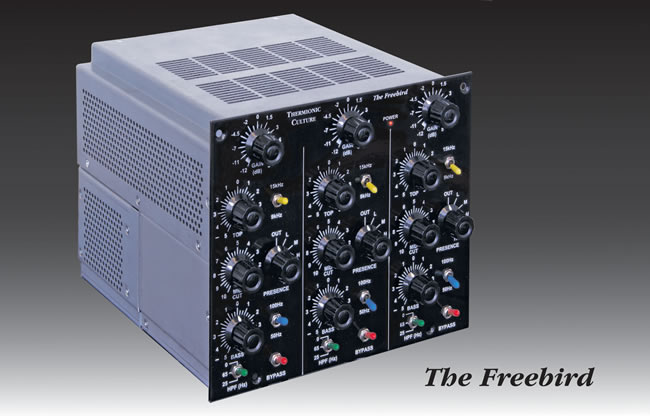
THE FREEBIRD
- 3 Channel valve eq. with a broad and musical nature adding warmth and naturality.
- Made in half rack format enabling use with a 2nd Freebird or a Nightingale.
- Built-in but detachable power supply.
- Baxandall 'Bass' and 'top' controls.
- 'Presence' control giving the user 5 unique lifting EQ curves.
- Indented and switched controls enabling recall.
- Gain control ranging from -12dB to +5dB.
- 'HPF' control gives 12dB/octave high pass filters operating at 25Hz and 65Hz.
- Can be used in conjunction with the output from a DAW without loss.
- Great Stereo buss eq. with a 'free' extra channel.
The Freebird is a 3 Channel valve Equaliser and comes in Thermionic Culture's half rack design format and has a built-in but detachable power supply. It will work normally as a stand alone unit but if desired The Freebird can be put in a Thermionic Culture 19 inch rack case together with another unit to give 6 channels of EQ, or you can add a different Thermionic Culture half rack unit such as The Nightingale.
The Freebird EQ circuit has a broad and musical nature. It adds a warmth and natural sounding character on it's own and can be used in conjunction with the output from a DAW to provide the character and natural feel that a plugin EQ will struggle to ever really match.
Having 3 channels means that this unit does not need to be consigned to a stereo bus alone, or it can be thought of as a multichannel type EQ such as that found on a classic mixing console.
The indented and switched controls give the user a high degree of recall-ability which is very useful when moving between mix projects.
The EQ section of The Freebird is based around several designs.
The Baxandall 'Bass' and 'Top' controls give the user 2 shelving EQs that can move continuously between cut or boost.
We have given two frequencies (15/9 KHz and 100/50Hz switched) at which the 'Top' and 'Bass' controls operate.
Just these controls alone give a very broad but powerful and interactive type of EQ.
The 'Presence' control gives the user 5 unique lifting EQ curves based around the midrange frequencies. This curve was first developed by Vic Keary in 1960 to emulate the difference in frequency response when playing back a tape machine track with an NAB curve when recorded with a CCIR curve.
Switched positions 'L', 'M' and 'H' take the curve centre from around 700Hz to around 3KHz with a boost of approximately 3dB. Positions 'H+' and 'H++' take the lift of the 'H' curve up by 5dB and 8dB respectively.
The 'Midcut' is a 31 position indented pot that gives the user a narrow cut in frequencies at 700Hz continuously variable from 0 to 20dB. This EQ curve is taken from The Rooster 'mid cut' control as it proved to be so popular with users.
The 'HPF' control gives 12dB/octave high pass filters operating at 25Hz and 65Hz. The 25Hz position will effectively remove unwanted sub bass frequencies and also allow the user to go further with the amount of bass boost that they choose to use.
The Gain control is an indented continuously variable control and it can either help the user to match the EQ'd signal's apparent volume to the un-EQ'd volume. Or it can allow the user to experiment with the variation in sound with operating level.
The Input is transformer balanced so that any input can be applied to the Freebird without any loss of level. The output is unbalanced to preserve the great "open" quality for which this kind of circuit is renowned. The Bypass switch removes all the electronics enabling a comparison to be made between the original and the eq'd signal, with the aid of the gain control.


